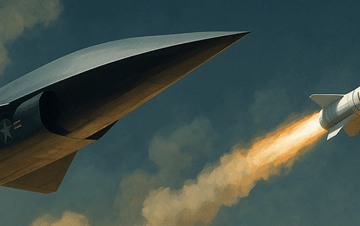On November 21, 2024, Russia struck the Pivdenmash aerospace factory in Dnipro, Ukraine, with six warheads delivered by an intermediate-range ballistic missile (IRBM). Each warhead dispensed a group of six non-nuclear, kinetic submunitions. The attack, in retaliation for Ukrainian strikes on Russia using the American Army Tactical Missile System (ATACMS) ballistic missiles and British Storm Shadow cruise missiles, appears to introduce a new level of conventional capability with greater range, penetration, and destructiveness.
This single-missile attack was launched from the Sary Shagan missile test complex near Astrakhan, almost 700 kilometers from the target. In remarks later that day, Vladimir Putin identified the delivery vehicle as an intermediate-range ballistic missile known as Oreshnik. The missile has been linked, variously, by the Pentagon to a terminated project, likely an intermediate-range multiple-warhead missile project known as Rubezh, and by the Ukrainian intelligence service to a future replacement for the SS-27 Mod 2 ICBM known as Kedr (translated as Cedar) that is just entering engineering development.
Further, at least one component identified in the debris from the missile had markings associated with the Bulava submarine-launched ballistic missile (SLBM). These missiles (Rubezh, Kedr, and Bulava) are designed by the Moscow Institute of Thermal Technology, as is likely the case with Oreshnik. Rubezh and a version of the SS-27 Mod 2 were tested with a new warhead deployment concept in which each warhead is called an “independent dispersal unit” (Russian acronym BIR) with its own deployment motor rather than being deployed from a single warhead bus in a more traditional multiple independently targetable reentry vehicle (MIRV) configuration. This feature, along with flight in a more fuel-consuming depressed trajectory, may make the warheads more difficult to intercept.
To date, no official damage assessments for the Pivdenmash facility are published. Putin compared the effect of a conventional Oreshnik strike to that of a nuclear weapon. However, reporting in the UK Daily Mail five days after the attack indicated that the damage was not as extensive as advertised. Ukrainian press reporting was similarly dismissive. The Kyiv Post reported that satellite imagery did not show the expected damage and recounted Russian war blogger expressions of disappointment or disbelief of the Russian official claims. American and NATO experts are said to be investigating the site, but no statements have been released yet.
Putin indicated that Oreshnik was not a weapon of mass destruction, in that it was not nuclear-armed. Examination of debris at the site indicated that the submunitions did not appear to carry high explosives; their effect was purely kinetic. At the reported impact velocity of Mach 11 (3,740 meters/second at sea level), the kinetic energy of an incoming projectile is about 7 mega-joules per kilogram (MJ/kg), which is almost 70 percent higher than the chemical energy content of TNT at 4.2 MJ/kg.
The choice of using 36 relatively large mass submunitions dispersed from the independent warheads may not have been the optimal choice for such an attack. A more effective approach may be more like systems researched and tested by the US that have been described as a “big shotgun shell.” Through the controlled use of conventional explosives to scatter fragments, one can place a desired fragment pattern on a target by selecting a height of burst appropriate to the incoming speed of the warhead and the expected fragment sizes.
Two examples are instructive. First, consider metal fragments of 50 grams each, roughly equivalent to a .50 caliber bullet; at Mach 11, each fragment has roughly ten times greater kinetic energy. The number of such fragments expected from an 800-kilogram payload (not counting structure and controls) would be 16,000.
First, if the height of burst is set to disperse 1 fragment per square meter, then the radius of the “shotgun” pattern is about 70 meters. Consequently, a fully fragmented warhead could theoretically cover about 4 acres in one shot, which would probably have produced far more devasting surface effects on the Pivdenmash complex, which is assumed to be a relatively soft target.
Second, for an increased fragment mass of 100 grams, the mass of a 25-millimeter (mm) cannon armor-piercing round, then the kinetic energy for an intermediate range ballistic missile (IRBM) -delivered, Mach 11 100-gram fragment is about 7 times higher than a cannon-fired round. Such energies raise the likely prospect of even penetrating ceilings and floors to vulnerable basement spaces. The parameters can be varied to maximize effectiveness, but at 1 fragment per square meter, the affected area will be reduced to about 1 acre.
Because of the hypersonic velocities of ballistic missile–delivered fragmenting munitions, fragment energies delivered by an IRBM will, in virtually every case, deposit significantly more energy than similarly sized munitions fired from rifles and cannons.
Conventionally armed Oreshnik allows Putin the option of shifting away from a strategy of repeated nuclear threats and reducing the need to violate the so-called nuclear taboo, for which the consequences are unknown following the first breach. It provides Russia an additional high-speed delivery option on the conventional side of the conventional-nuclear integration space. Nevertheless, given that a Russian IRBM can also be designed to carry a nuclear payload, and deliver it at transcontinental range, it also provides an additional high-speed nuclear option.
Col. (Ret.) David Rehbein is a former US Army FA52 and consultant for the National Strategic Research Institute. John Swegle, PhD, spent his career at Sandia National Laboratories, Lawrence Livermore National Lab, and Savannah River National Lab. He is also a consultant for the National Strategic Research Institute and a Senior Fellow at the National Institute for Deterrence Studies. Views expressed are their own.





Great article. Very fact-filled and informative.